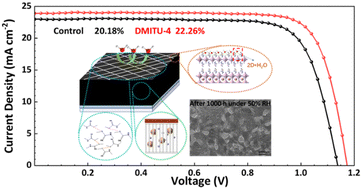Surface pre-sacrifice behavior of thiourea-based 2D perovskites for high-performance perovskite solar cells†
Abstract
The utilization of organic cation passivation agents to construct two-dimensional/three-dimensional (2D/3D) heterostructures is one of the most effective strategies for achieving efficient and stable perovskite solar cells (PSCs). In this study, we developed a surface pre-sacrifice strategy by introducing the thiourea-based organic cation (1,2-dimethylisothiourea, DMITU) to passivate interface defects and stabilize the surface of the 3D perovskite. This approach is used in the preparation of high-quality 2D/3D heterojunction perovskite films, exhibiting an enhanced power conversion efficiency (PCE) of 22.26% (20.18% for control). Importantly, the S–S interaction of DMITU, along with the sacrificial performance of the 2D perovskite layer under water and heat exposure, leads to the formation of a network-like 2D intermediate phase protective barrier on the perovskite surface. This barrier endows the DMITU perovskite with higher hydrophobicity and improved performance, thus delaying the degradation of the 3D perovskite during aging. The interaction between DMITU and Pb2+, I−/Br− and FA+/MA+, along with the formation of the 2D perovskite, effectively promotes defect passivation and inhibits ion migration. As a result, the DMITU perovskites exhibit excellent long-term stability against humidity and heat. This discovery highlights the potential of incorporating organic ammonium salts to achieve 2D/3D heterojunctions as a promising approach for high-performance PSCs.



 Please wait while we load your content...
Please wait while we load your content...